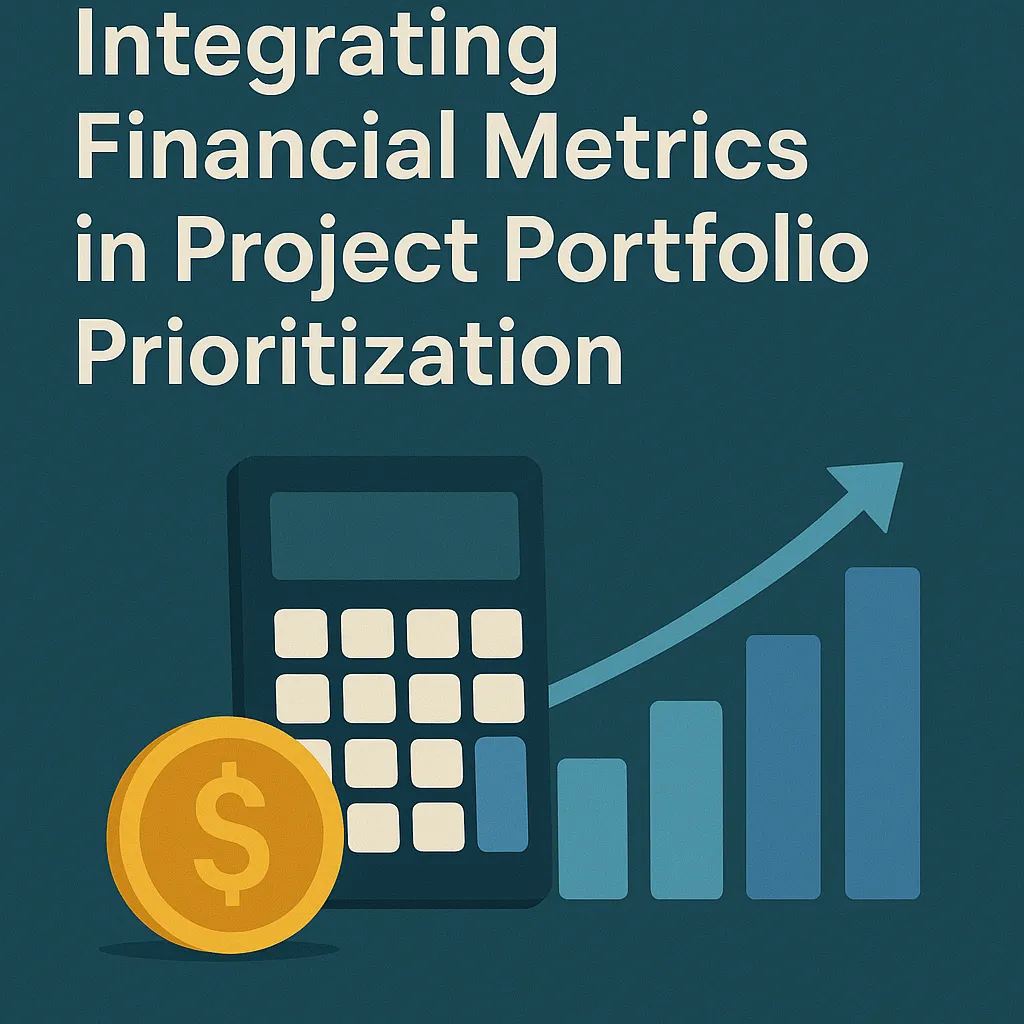Introduction
Project portfolio prioritization is a critical process that involves evaluating and ranking projects based on their potential value, costs, resources, and strategic importance. This systematic approach enables organizations to allocate resources effectively and focus on projects that align with their overarching goals. By prioritizing projects, organizations can ensure that they are investing in initiatives that not only promise the best returns but also support their strategic objectives.
Financial metrics play a pivotal role in this decision-making process. They provide a quantitative basis for evaluating the potential success of projects, allowing project managers and financial analysts to make informed choices. Key financial indicators such as Return on Investment (ROI), Net Present Value (NPV), and Internal Rate of Return (IRR) serve as essential tools in assessing the viability and profitability of projects. These metrics help in translating complex financial data into actionable insights, facilitating a clearer understanding of how each project contributes to the organization’s financial health and strategic direction.
Moreover, aligning project selection with organizational financial goals is paramount for achieving long-term success. When projects are evaluated through the lens of financial performance, organizations can ensure that their project portfolios are not only strategically aligned but also financially sound. This alignment fosters a culture of accountability and transparency, where project outcomes are directly linked to financial performance. By integrating financial metrics into project portfolio prioritization, organizations can enhance their decision-making processes, ultimately leading to more successful project outcomes and a stronger alignment with their financial objectives.
Understanding Project Portfolio Prioritization
Project portfolio prioritization is a critical process in project management that involves selecting and ranking projects based on specific criteria to ensure that resources are allocated effectively and strategic goals are met. This section will delve into the foundational aspects of project portfolio prioritization, emphasizing the integration of financial metrics to enhance decision-making.
Criteria for Project Selection and Prioritization
The selection and prioritization of projects are guided by several key criteria, which may include:
- Alignment with Strategic Objectives: Projects should align with the organization’s strategic goals to ensure that they contribute to overall business success. This alignment helps in justifying the investment of resources into specific projects [1].
- Financial Metrics: Financial analysis plays a crucial role in project prioritization. Metrics such as return on investment (ROI), net present value (NPV), and payback period are commonly used to evaluate the financial viability of projects. By incorporating these metrics, organizations can make informed decisions that maximize financial returns [5].
- Feasibility and Risk Assessment: Evaluating the feasibility of projects, including potential risks and resource requirements, is essential. This assessment helps in understanding the likelihood of project success and the impact of potential challenges [3].
Impact of Prioritization on Resource Allocation and Project Success
Effective project prioritization directly influences resource allocation and overall project success. By prioritizing projects based on strategic importance and financial viability, organizations can:
- Optimize Resource Utilization: Prioritization ensures that limited resources are allocated to projects that offer the highest potential returns, thereby maximizing efficiency and effectiveness [2].
- Enhance Project Outcomes: Projects that are aligned with strategic goals and backed by solid financial analysis are more likely to succeed. This alignment fosters a focused approach, reducing the likelihood of project failure and increasing the chances of achieving desired outcomes [4].
Common Frameworks Used for Prioritization
Several frameworks are commonly employed in project portfolio prioritization, each offering unique methodologies for evaluating and ranking projects:
- MoSCoW Method: This framework categorizes projects into four groups: Must have, Should have, Could have, and Won’t have. This prioritization helps teams focus on essential projects while managing stakeholder expectations effectively [8].
- Weighted Scoring Model: This approach involves assigning weights to various criteria based on their importance and scoring projects against these criteria. The total score helps in ranking projects, allowing for a more nuanced evaluation that considers multiple factors, including financial metrics [7].
The Role of Financial Metrics in Project Selection
Financial metrics play a pivotal role in guiding project selection decisions. By integrating these metrics into the prioritization process, organizations can ensure that their project investments align with strategic goals while maximizing returns. Here are some key financial metrics that are essential for effective project portfolio prioritization:
- Return on Investment (ROI): This metric measures the profitability of a project relative to its costs. A higher ROI indicates a more favorable investment, making it a critical factor in determining project viability. It helps project managers and financial analysts assess which projects will yield the best financial returns for the organization [7].
- Net Present Value (NPV): NPV calculates the difference between the present value of cash inflows and outflows over a project’s lifespan. A positive NPV suggests that the project is expected to generate more value than it costs, thus supporting its selection. This metric is particularly useful for comparing projects with different cash flow patterns and timelines [7][14].
- Internal Rate of Return (IRR): IRR is the discount rate that makes the NPV of a project zero. It represents the expected annualized return on investment. Projects with an IRR that exceeds the organization’s required rate of return are typically prioritized, as they promise greater financial benefits [7].
- Payback Period: This metric indicates the time required to recover the initial investment in a project. A shorter payback period is often preferred, as it reduces the risk associated with long-term investments. Understanding the payback period helps organizations manage cash flow and liquidity effectively [14].
These financial metrics not only influence project viability but also contribute to the sustainability of project portfolios. By evaluating projects through a financial lens, organizations can prioritize those that align with their financial goals and risk tolerance. This approach ensures that resources are allocated to projects that promise the highest returns, thereby enhancing overall portfolio performance [15].
However, it is essential to strike a balance between qualitative and quantitative factors in decision-making. While financial metrics provide valuable insights, they do not capture the full picture. Qualitative factors, such as stakeholder satisfaction, strategic alignment, and potential risks, must also be considered. A comprehensive project selection process that integrates both financial analysis and qualitative assessments will lead to more informed and effective prioritization decisions [6][15].
Integrating Financial Analysis into Prioritization Frameworks
In Project Portfolio Management (PPM), the integration of financial metrics into project prioritization is essential for aligning projects with strategic objectives and maximizing resource utilization. This section will explore practical methods for embedding financial analysis into prioritization frameworks, discuss tools that facilitate this process, and provide case studies that illustrate successful implementations.
Methods for Embedding Financial Metrics into Prioritization Models
- Scoring Models: One effective method for prioritizing projects is the use of scoring models, where each project is evaluated based on various financial criteria such as return on investment (ROI), net present value (NPV), and payback period. By assigning weights to these metrics, organizations can create a comprehensive score that reflects the financial viability of each project, allowing for informed decision-making regarding project selection [9].
- Cost-Benefit Analysis: This method involves comparing the expected costs of a project against its anticipated benefits. By quantifying both direct and indirect financial impacts, project managers can prioritize initiatives that offer the greatest net benefit to the organization. This analysis can be integrated into existing prioritization frameworks to enhance decision-making [2].
- Portfolio Optimization Techniques: Advanced financial metrics can be utilized to optimize the project portfolio. Techniques such as linear programming or Monte Carlo simulations can help in assessing the risk and return profiles of various projects, enabling managers to select a balanced portfolio that aligns with the organization’s risk appetite and strategic goals [11].
Tools and Software for Financial Analysis and Prioritization
To effectively integrate financial analysis into project prioritization, various tools and software solutions are available:
- Celoxis: This platform offers integrated financial management features that provide a centralized hub for managing project budgets, forecasts, and variances. Its capabilities allow project managers to analyze financial data alongside project schedules and resources, facilitating better prioritization decisions [1].
- Oracle PPM Cloud: This solution provides comprehensive project portfolio management tools that include financial analysis capabilities. It allows organizations to track project performance against financial metrics, enabling more informed prioritization based on real-time data [4].
- Microsoft Project: While primarily a project management tool, Microsoft Project can be enhanced with financial analysis plugins that allow users to incorporate financial metrics into their project prioritization processes, making it easier to align projects with strategic financial goals.
Challenges in Integrating Financial Metrics
Incorporating financial metrics into project portfolio prioritization can significantly enhance decision-making processes for financial analysts and project managers. However, several challenges can hinder the effective integration of these metrics. Here are some common obstacles and potential solutions:
- Data Availability: One of the primary challenges is the availability and quality of financial data. Organizations often struggle to gather accurate and timely financial information necessary for effective analysis. This can lead to incomplete assessments of project viability and potential returns. To overcome this, organizations should invest in robust data management systems that ensure data integrity and accessibility, enabling project managers to make informed decisions based on reliable financial metrics [1].
- Stakeholder Buy-In: Gaining the support of key stakeholders is crucial for the successful integration of financial metrics. Resistance may arise due to differing priorities or a lack of understanding of the financial implications of project decisions. To address this, project managers should engage stakeholders early in the process, providing clear communication about the benefits of using financial metrics. Workshops and presentations can help illustrate how financial analysis aligns with organizational goals, fostering a collaborative environment [2].
- Over-Reliance on Financial Metrics: While financial metrics such as return on investment (ROI) and net present value (NPV) are essential for project evaluation, an over-reliance on these figures can lead to neglecting strategic goals and non-financial factors. This can result in a portfolio that is financially sound but misaligned with the organization’s long-term vision. To mitigate this risk, project managers should adopt a balanced approach that incorporates both financial and non-financial criteria, ensuring that project selection aligns with strategic objectives and organizational values [3].
- Resource Constraints: Limited resources, including time and skilled personnel, can pose significant challenges in implementing financial analysis effectively. Organizations may find it difficult to allocate sufficient resources to conduct thorough financial evaluations for all potential projects. To overcome this, prioritization frameworks can be developed that streamline the evaluation process, allowing project managers to focus on high-impact projects while ensuring that financial assessments are still conducted efficiently [4].
By recognizing these challenges and implementing strategic solutions, organizations can enhance their project portfolio prioritization processes. Integrating financial metrics effectively not only improves decision-making but also aligns project selection with broader organizational goals, ultimately driving better business outcomes.
Best Practices for Financially Driven Project Portfolio Prioritization
Integrating financial metrics into project portfolio prioritization is essential for organizations aiming to maximize their returns on investment while aligning projects with strategic objectives. Here are actionable best practices that financial analysts and project managers can implement to enhance their project selection decisions:
- Regular Reviews and Updates of Financial Metrics: It is crucial to establish a routine for reviewing and updating financial metrics such as Net Present Value (NPV), Return on Investment (ROI), and Internal Rate of Return (IRR). These metrics should be revisited frequently to reflect changes in market conditions, project scopes, and organizational goals. By maintaining current financial data, organizations can make informed decisions that align with their strategic objectives and adapt to evolving circumstances [1][6].
- Cross-Functional Collaboration: Encouraging collaboration between finance and project teams can lead to more comprehensive project evaluations. Financial analysts can provide insights into the financial implications of projects, while project managers can share operational perspectives. This synergy can enhance the understanding of project value and risk, leading to better prioritization decisions. Establishing regular communication channels and joint planning sessions can facilitate this collaboration [2][8].
- Continuous Learning and Adaptation: The landscape of project management is dynamic, and organizations must embrace a culture of continuous learning. This involves not only staying updated on financial analysis techniques but also being open to adapting prioritization criteria based on past project performances and emerging trends. By fostering an environment that values feedback and iterative improvement, organizations can refine their project selection processes and enhance overall portfolio performance [3][7].
By implementing these best practices, organizations can effectively leverage financial metrics in their project portfolio prioritization efforts, ensuring that they select initiatives that deliver the highest value and align with their strategic goals.
Conclusion
The integration of financial metrics into project prioritization is not just beneficial; it is essential for making informed and strategic project selection decisions. Financial metrics such as Return on Investment (ROI), Net Present Value (NPV), and Internal Rate of Return (IRR) provide critical insights that help organizations evaluate the potential financial returns of various projects, ensuring that resources are allocated to initiatives that align with strategic objectives and deliver maximum value [10][12].
Moreover, the collaboration between financial analysts and project managers is crucial in this process. By working together, these professionals can leverage their unique expertise to create a more comprehensive understanding of project viability. Financial analysts can provide the necessary financial data and analysis, while project managers can offer insights into project feasibility and alignment with organizational goals. This partnership fosters a holistic approach to project selection, enhancing the overall effectiveness of project portfolio management [14][15].
In conclusion, the integration of financial analysis in project portfolio prioritization is a vital step towards achieving greater project success and organizational efficiency. Embracing this approach will empower financial analysts and project managers alike to make more informed decisions that drive value and foster sustainable growth.
Find out more about Shaun Stoltz https://www.shaunstoltz.com/about/.
This post was written by an AI and reviewed/edited by a human.



